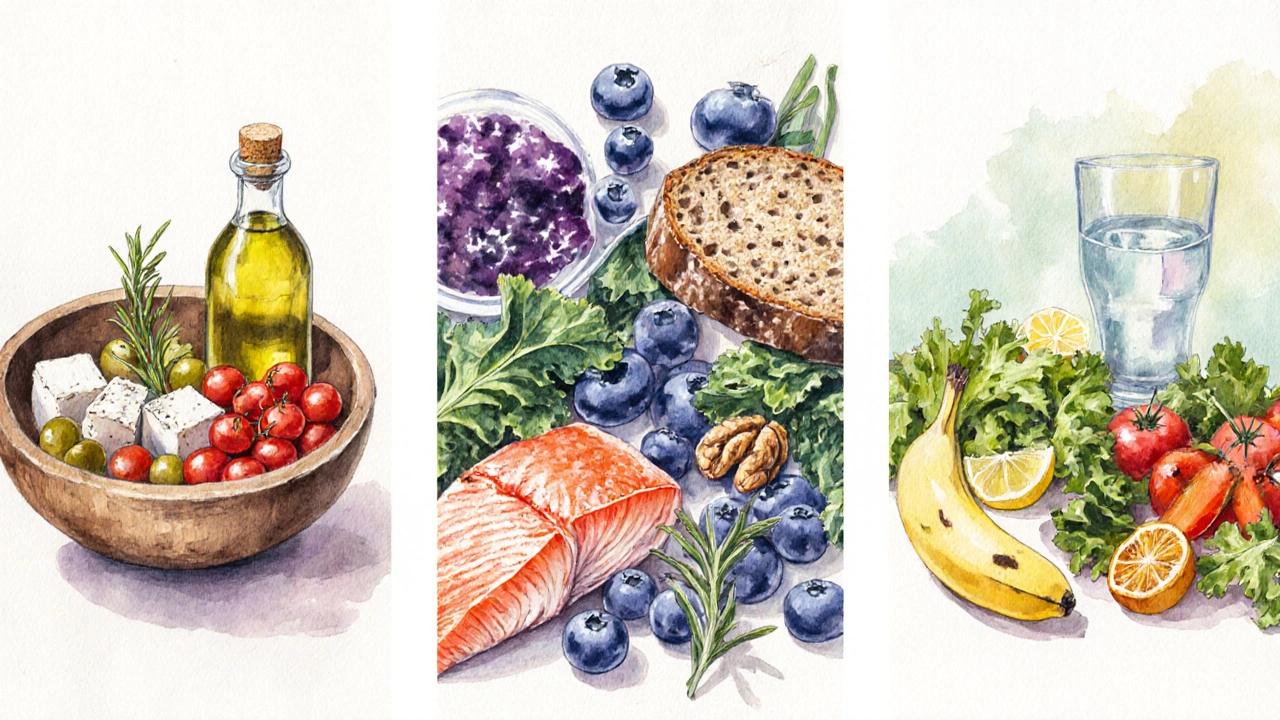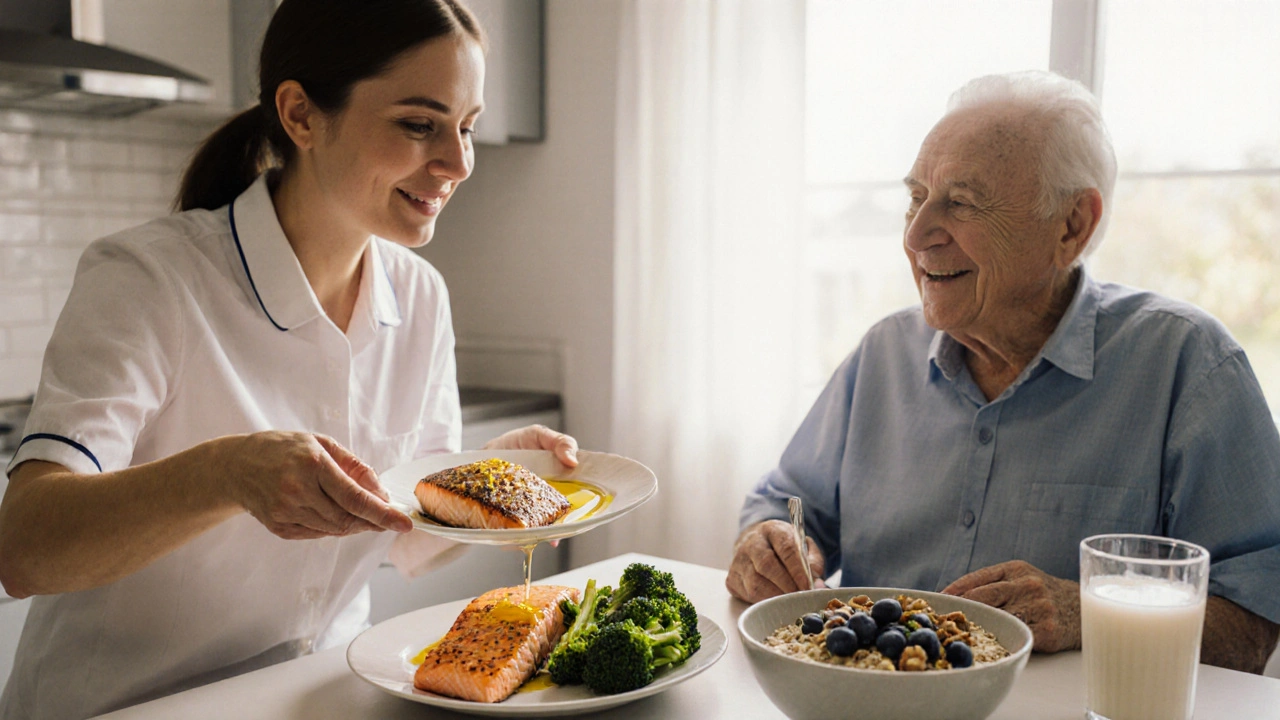Alzheimer's Diet Planner
Your Recommended Diet Plan
Quick Takeaways
- Balanced meals rich in omega‑3s, antioxidants, and B‑vitamins can slow cognitive decline.
- The Mediterranean, MIND, and DASH diets have the strongest research backing for Alzheimer’s patients.
- Caregivers should focus on meal timing, hydration, and easy‑to‑prepare foods.
- Regular check‑ins with a qualified dietitian help tailor nutrition to disease stage.
- Track weight, blood sugar, and mood to gauge nutritional effectiveness.
Understanding Alzheimer’s and the Role of Nutrition
When we talk about proper nutrition for Alzheimer’s patients-the set of foods and dietary habits that specifically support brain health in people diagnosed with Alzheimer’s disease, we’re dealing with more than just calories. Alzheimer’s diseasea progressive neurodegenerative disorder that impairs memory, reasoning, and daily functioning creates metabolic changes that make the brain especially vulnerable to inflammation, oxidative stress, and nutrient deficiencies.
Research from 2023‑2024 shows that patients who follow a brain‑friendly diet can experience up to a 30% slower rate of cognitive decline compared with those on a typical Western diet. The key is delivering the right mix of macronutrients (healthy fats, lean protein, complex carbs) and micronutrients (vitamins, minerals, phytonutrients) at consistent intervals.

Core Nutrients That Make a Difference
Below are the nutrients that consistently appear in the scientific literature as protective for Alzheimer’s patients.
- Omega‑3 fatty acids - especially DHA and EPA. They support neuronal membrane fluidity and reduce inflammation. Sources: fatty fish (salmon, sardines), walnuts, chia seeds.
- Antioxidants - such as vitamins C and E, flavonoids, and polyphenols. They combat oxidative damage caused by free radicals. Sources: berries, leafy greens, green tea, dark chocolate (70%+ cacao).
- B‑vitamins - B6, B9 (folate), and B12 help lower homocysteine levels, an amino‑acid linked to brain atrophy. Sources: legumes, fortified cereals, eggs, lean meat.
- Vitamin D - influences brain signalling and inflammation. Low levels are common in older adults. Sunlight exposure plus fortified dairy, fatty fish, or supplements are needed.
- Magnesium and zinc - assist in synaptic transmission and antioxidant enzyme function. Sources: nuts, seeds, whole grains, pumpkin seeds.
Pairing these nutrients with a moderate amount of high‑quality protein helps maintain muscle mass, which is crucial for mobility and overall independence.
Best Diet Patterns Backed by Science
Three eating patterns stand out as the most consistently beneficial for people living with Alzheimer’s.
| Feature | Mediterranean Diet | MIND Diet | DASH Diet |
|---|---|---|---|
| Core focus | Olive oil, fish, plant‑based foods | Combines Mediterranean with specific brain‑boosting foods | Low‑salt, high‑potassium, heart‑healthy |
| Key brain nutrients | Omega‑3, antioxidants | Omega‑3, B‑vitamins, vitamin E, leafy greens | Magnesium, potassium, calcium |
| Research support | 30% slower decline (2022 cohort) | Reduced risk of AD by 53% (MIND study) | Improved blood pressure, indirect cognitive benefit |
| Ease for caregivers | Simple: olive oil, canned fish, fresh produce | Requires specific foods like blueberries and nuts weekly | Focuses on low‑sodium processed foods-good for meal prep |
All three diets emphasize whole foods, limited red meat, and minimal added sugars. The MIND dieta hybrid of Mediterranean and DASH eating plans that adds brain‑specific foods like berries and green leafy vegetables is the most targeted for Alzheimer’s, but the Mediterranean diet is often easier to implement for families with limited shopping time.
Practical Meal Planning Tips for Caregivers
Caregivers are the frontline of nutrition delivery. Here are actionable steps that fit into a typical day.
- Start with a simple breakfast-oatmeal topped with blueberries, a sprinkle of walnuts, and a splash of fortified soy milk (vitaminD and B‑12).
- Schedule meals every 3-4hours to keep blood sugar stable, reducing agitation and confusion.
- Hydration matters: aim for 6-8 cups of water daily. Offer herbal teas or diluted fruit juice if plain water is refused.
- Batch‑cook protein: bake a tray of salmon with olive oil and herbs; portion into freezer bags for quick reheating.
- Incorporate “brain snacks” mid‑day-carrot sticks with hummus, a handful of almonds, or a small piece of dark chocolate.
- Use visual cues: label containers with pictures of the food to aid recognition and encourage independence.
- Consult a dietitiana health professional trained to design personalized nutrition plans at least once a quarter to adjust portions and address emerging concerns.
When taste changes occur-a common issue in later stages-experiment with herbs, spices, and texture variations (smooth soups vs. chunky stews) to keep meals appealing.

Common Pitfalls & How to Avoid Them
Even with the best intentions, caregivers can stumble into habits that undermine nutrition.
- Relying on processed “meal‑replacement” shakes. These often lack the fiber and phytonutrients needed for gut health. Use them only as supplements, not replacements.
- Skipping meals during busy mornings. A missed breakfast can trigger low blood glucose, leading to irritability. Prepare grab‑and‑go options like a banana‑nut butter wrap.
- Over‑salting to improve flavor. Excess sodium worsens hypertension, which is linked to faster cognitive decline. Opt for herbs, lemon zest, or garlic for taste.
- Neglecting vitamin D. Many older adults stay indoors; a simple daily 800‑1000IU supplement (after consulting a doctor) can bridge the gap.
- Ignoring weight loss signs. Unintended weight loss often signals inadequate intake or malabsorption. Track weight weekly and adjust calorie density with healthy fats like avocado or olive oil.
Monitoring Progress and Adjusting the Plan
Nutrition is not a set‑and‑forget strategy. Keep an eye on these metrics:
- Weight and BMI: Sudden drops may require calorie‑dense meals.
- Blood glucose levels: Stable readings indicate balanced carbohydrate intake.
- Blood pressure: High readings suggest excess sodium.
- Mood and behavior: Improvements in agitation often correlate with stable nutrition.
- Cognitive assessments: Periodic Mini‑Mental State Exam (MMSE) scores can help gauge any slow‑down in decline.
Document findings in a simple notebook or app, and review them with the healthcare team every 3 months.
Frequently Asked Questions
Can a specific food reverse Alzheimer’s?
No single food can cure or reverse Alzheimer’s, but a diet rich in omega‑3s, antioxidants, and B‑vitamins can slow progression and improve quality of life.
How much fish should an Alzheimer’s patient eat each week?
Aim for two servings (about 3‑4oz each) of fatty fish like salmon, sardines, or mackerel per week to meet DHA/EPA recommendations.
Are supplements necessary if the diet is balanced?
Supplements can fill gaps-especially vitaminD and B12-but should be taken only after a blood test and physician approval.
What’s the best way to keep a patient hydrated?
Offer fluids regularly, use a straw cup or sip‑assist bottle, and incorporate water‑rich foods like cucumbers, watermelon, and soups.
How often should the nutrition plan be reviewed?
Every three months, or sooner if there are noticeable changes in weight, blood tests, or cognitive status.
Proper nutrition isn’t a magic bullet, but it’s a powerful tool that families can control. By focusing on nutrient‑dense foods, following proven diet patterns, and staying vigilant about changes, caregivers give Alzheimer’s patients a better chance at maintaining independence and enjoying daily meals.

Andrea Dunn
October 10, 2025 AT 22:40Don't be fooled, the so‑called "Mediterranean diet" is just a propaganda tool pushed by global elites to control our food supply 😒.
Erin Johnson
October 19, 2025 AT 15:17Wow, this guide really nails the basics-good job! It’s impressive how the MIND diet blends Mediterranean and DASH principles while zeroing in on brain‑boosting foods.
But hey, if you can’t find blueberries, frozen mixed berries work just fine-just don’t forget the walnuts for that extra crunch.
Overall, keep up the solid work, and maybe add a quick cheat‑sheet for caregivers on portion sizes. 🙃
Rica J
October 28, 2025 AT 07:53Hey guys, loved the detail here! Just a heads up – watch out for the spelling of "omega‑3" – sometimes people write it as "omega3" which can be confusing.
Also, you might want to mention that fortified soy milk is a great veg option for B‑12 and vitamin D, especially for vegans.
Other than that, the table is super helpful – keep it up!
Linda Stephenson
November 6, 2025 AT 00:30I really appreciate the inclusive tone of this post. It’s great to see practical tips like labeling containers with pictures – that can make a huge difference for patients with visual recognition issues.
Also, reminding caregivers to track weight weekly is spot on. Keep spreading this valuable info!
Sunthar Sinnathamby
November 14, 2025 AT 17:07This is exactly the kind of uplifting guidance families need. The suggestion to batch‑cook salmon and freeze portions is a lifesaver for busy caregivers.
Remember to add a squeeze of lemon before reheating – it brightens the flavor and encourages better appetite. Keep the energy coming!
Catherine Mihaljevic
November 23, 2025 AT 09:44Another so‑called "science‑backed" diet? Wake up, they’re just selling you overpriced supplements while pushing an agenda.
Omega‑3s? You can get that from any cheap fish, no need for fancy diet plans.
Don’t trust the hype.
Michael AM
December 2, 2025 AT 02:21Great rundown! I’ve seen the difference a consistent meal schedule makes for patients’ mood. Keep sharing these practical tips.
Rakesh Manchanda
December 10, 2025 AT 18:58While the article is thorough, one must consider the socioeconomic constraints that prevent many from adhering to such refined regimens. Nevertheless, the information is valuable.